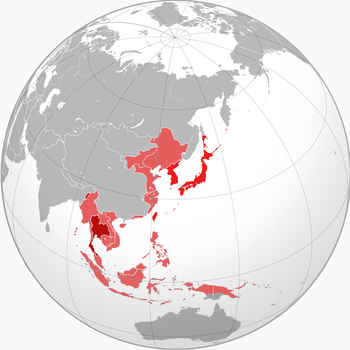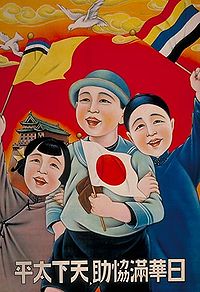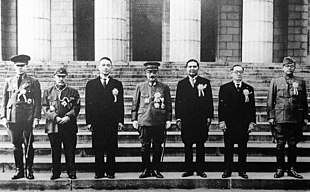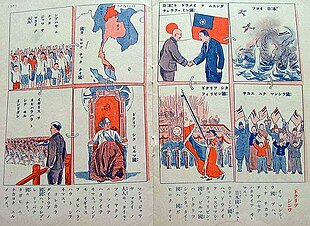|
Greater East Asia Co-Prosperity Sphere

The Greater East Asia Co-Prosperity Sphere (Japanese: 大東亞共榮圈, Hepburn: Dai Tōa Kyōeiken), also known as the GEACPS,[1] was a pan-Asian union that the Empire of Japan tried to establish. Initially, it covered Japan (including annexed Korea), Manchukuo, and China, but as the Pacific War progressed, it also included territories in Southeast Asia and parts of India.[2] The term was first coined by Minister for Foreign Affairs Hachirō Arita on June 29, 1940.[3] The proposed objectives of this union were to ensure economic self-sufficiency and cooperation among the member states, along with resisting the influence of Western imperialism and Soviet communism.[4] In reality, militarists and nationalists saw it as an effective propaganda tool to enforce Japanese hegemony.[3] The latter approach was reflected in a document released by Japan's Ministry of Health and Welfare, An Investigation of Global Policy with the Yamato Race as Nucleus, which promoted racial supremacist theories.[5] Japanese spokesmen openly described the Greater East Asia Co-Prosperity Sphere as a device for the "development of the Japanese race."[6] When World War II ended, the Greater East Asia Co-Prosperity Sphere became a source of criticism and scorn for Allies.[7] Development of the concept The concept of a unified Asia under Japanese leadership had its roots dating back to the 16th century. For example, Toyotomi Hideyoshi proposed to make China, Korea, and Japan into "one". Moreover, Hideyoshi had further plans to expand into India, the Philippines, and other islands in the Pacific.[8][9]: 99-100 Modern conceptions emerged in 1917. During the proceedings of the Lansing-Ishii Agreement, Japan explained to Western observers that their expansionism in Asia was analogous to the United States' Monroe Doctrine.[3] This conception was influential in the development of the Greater East Asia Co-Prosperity concept, with the Japanese Army also comparing it to the Roosevelt Corollary.[2] One of the reasons why Japan adopted imperialism was to resolve domestic issues such as overpopulation and resource scarcity. Another reason was to withstand Western imperialism.[3] On November 3, 1938, Prime Minister Fumimaro Konoe and Minister for Foreign Affairs Hachirō Arita proposed the development of the New Order in East Asia (東亜新秩序[10], Tōa Shin Chitsujo), which was limited to Japan, China, and the puppet state of Manchukuo.[11] They believed that the union had 6 purposes:[3]
The vagueness of the above points were effective in making people more agreeable to militarism and collaborationism.[3] On June 29, 1940, Arita renamed the union the Greater East Asia Co-Prosperity Sphere, which he announced by radio address. At Yōsuke Matsuoka's advice, Arita emphasised on the economic aspects more. On August 1, Konoe, who still used the original name, expanded the scope of the union to include the territories of Southeast Asia.[3] On November 5, Konoe reaffirmed that a Japan–Manchukuo–China yen bloc[12] would continue and be "perfected".[3] HistoryThe outbreak of World War II in Europe gave the Japanese an opportunity to fulfill the objectives of the Greater East Asia Co-Prosperity Sphere, without significant pushback from the Western powers or China.[13] This entailed the conquest of Southeast Asian territories to extract their natural resources. If territories were unprofitable, the Japanese would encourage their subjects, including those in mainland Japan, to endure "economic suffering" and prevent outflow of material to the enemy. Nonetheless, they preached the moral superiority of cultivating a "spiritual essence" instead of prioritising material gain like Western powers.[4] After Japanese advancements into French Indochina in 1940, knowing that Japan was completely dependent on other countries for natural resources, U.S. President Franklin D. Roosevelt ordered a trade embargo on steel and oil, raw materials that were vital to Japan's war effort.[14] Without steel and oil imports, Japan's military could not fight for long.[14] As a result of the embargo, Japan decided to attack the British and Dutch colonies in Southeast Asia from 7 to 19 December 1941, seizing the raw materials needed for the war effort.[14] These efforts were successful, with Japanese politician Nobusuke Kishi announcing via radio broadcast that vast resources were available for Japanese use in the newly conquered territories.[15] As part of its war drive in the Pacific, Japanese propaganda included phrases like "Asia for the Asiatics" and talked about the need to "liberate" Asian colonies from the control of Western powers.[16] They also planned to change the Chinese hegemony in the agricultural market in Southeast Asia with Japanese immigrants to boost its economic value, with the former being despised by Southeast Asian natives.[4] The Japanese failure to bring the ongoing Second Sino-Japanese War to a swift conclusion was blamed in part on the lack of resources; Japanese propaganda claimed this was due to the refusal by Western powers to supply Japan's military.[17] Although invading Japanese forces sometimes received rapturous welcomes throughout recently captured Asian territories due to anti-Western and occasionally, anti-Chinese sentiment,[4] the subsequent brutality of the Japanese military led many of the inhabitants of those regions to regard Japan as being worse than their former colonial rulers.[16] The Japanese government directed that economies of occupied territories be managed strictly for the production of raw materials for the Japanese war effort; a cabinet member declared, "There are no restrictions. They are enemy possessions. We can take them, do anything we want".[18] For example, according to estimates, under Japanese occupation, about 100,000 Burmese and Malay Indian labourers died while constructing the Burma-Siam Railway.[19] The Japanese sometimes spared ethnic groups, such as Chinese immigrants, if they supported the war effort, whether sincerely or not.[4] An Investigation of Global Policy with the Yamato Race as Nucleus – a secret document completed in 1943 for high-ranking government use – laid out that Japan, as the originator and strongest military power within the region, would naturally take the superior position within the Greater East Asia Co-Prosperity Sphere, with the other nations under Japan's umbrella of protection.[20][5] Japanese propaganda was useful in mobilizing Japanese citizens for the war effort, convincing them Japan's expansion was an act of anti-colonial liberation from Western domination.[21] The booklet Read This and the War is Won—for the Japanese Army—presented colonialism as an oppressive group of colonists living in luxury by burdening Asians. According to Japan, since racial ties of blood connected other Asians to the Japanese, and Asians had been weakened by colonialism, it was Japan's self-appointed role to "make men of them again" and liberate them from their Western oppressors.[22] According to Foreign Minister Shigenori Tōgō (in office 1941–1942 and 1945), should Japan be successful in creating this sphere, it would emerge as the leader of Eastern Asia, and the Greater East Asia Co-Prosperity Sphere would be synonymous with the Japanese Empire.[23] Greater East Asia Conference : Japan and colonies : Japanese allies and occupied territory : Territories disputed and claimed by Japan and its allies   The Greater East Asia Conference (大東亞會議, Dai Tōa Kaigi) took place in Tokyo on 5–6 November 1943: Japan hosted the heads of state of various component members of the Greater East Asia Co-Prosperity Sphere. The conference was also referred to as the Tokyo Conference. The common language used by the delegates during the conference was English.[24] The conference was mainly used as propaganda.[25] At the conference, Tojo greeted them with a speech praising the "spiritual essence" of Asia instead of the "materialistic civilisation" of the West.[26] Their meeting was characterised by the praise of solidarity and condemnation of Western colonialism but without practical plans for either economic development or integration.[27] Because of a lack of military representatives at the conference, the conference served little military value.[25] With the simultaneous use of Wilsonian and Pan-Asian rhetoric, the goals of the conference were to solidify the commitment of certain Asian countries to Japan's war effort and to improve Japan's world image; however, the representatives of the other attending countries were in practice neither independent nor treated as equals by Japan.[28] The following dignitaries attended:
Imperial ruleThe ideology of the Japanese colonial empire, as it expanded dramatically during the war, contained two contradictory impulses. On the one hand, it preached the unity of the Greater East Asia Co-Prosperity Sphere, a coalition of Asian races directed by Japan against Western imperialism in Asia. This approach celebrated the spiritual values of the East in opposition to the "crass materialism" of the West.[29] In practice, however, the Japanese installed organisationally-minded bureaucrats and engineers to run their new empire, and they believed in ideals of efficiency, modernisation, and engineering solutions to social problems.[30] Japanese was the official language of the bureaucracy in all of the areas and was taught at schools as a national language.[31] Japan set up puppet regimes in Manchuria and China; they vanished at the war's end. The Imperial Army operated ruthless administrations in most conquered areas but paid more favourable attention to the Dutch East Indies. The main goal was to obtain oil but the Dutch colonial government destroyed the oil wells. However, the Japanese could repair and reopen them within a few months of their conquest. However, most tankers transporting oil to Japan were sunk by U.S. Navy submarines, so Japan's oil shortage became increasingly acute. Japan also sponsored an Indonesian nationalist movement under Sukarno.[32] Sukarno finally came to power in the late 1940s after several years of fighting the Dutch.[33] PhilippinesTo build up the economic base of the Co-Prosperity Sphere, the Japanese Army envisioned using the Philippine islands as a source of agricultural products needed by its industry. For example, Japan had a surplus of sugar from Taiwan, and a severe shortage of cotton, so they tried to grow cotton on sugar lands with disastrous results; they lacked the seeds, pesticides, and technical skills to grow cotton. Jobless farm workers flocked to the cities, where there was minimal relief and few jobs. The Japanese Army also tried using cane sugar for fuel, castor beans and copra for oil, Derris for quinine, cotton for uniforms, and abacá for rope. The plans were difficult to implement due to limited skills, collapsed international markets, bad weather, and transportation shortages. The program failed, giving very little help to Japanese industry and diverting resources needed for food production.[34] As Stanley Karnow writes, Filipinos "rapidly learned as well that 'co-prosperity' meant servitude to Japan's economic requirements".[35] Living conditions were poor throughout the Philippines during the war. Transportation between the islands was difficult because of a lack of fuel. Food was in short supply, with sporadic famines and epidemic diseases that killed hundreds of thousands of people.[36][37] In October 1943, Japan declared the Philippines an independent republic. The Japanese-sponsored Second Philippine Republic, headed by President José P. Laurel, proved to be ineffective and unpopular as Japan maintained very tight control.[38] FailureThe Co-Prosperity Sphere collapsed with Japan's surrender to the Allies in September 1945. Ba Maw, wartime President of Burma under the Japanese, blamed the Japanese military for the failure of the Co-Prosperity Sphere:
In other words, the Greater East Asia Co-Prosperity Sphere operated not for the betterment of all the Asian countries but for Japan's interests, and thus the Japanese failed to gather support in other Asian countries. Nationalist movements did appear in these Asian countries during this period, and these nationalists cooperated with the Japanese to some extent. However, Willard Elsbree, professor emeritus of political science at Ohio University, claims that the Japanese government and these nationalist leaders never developed "a real unity of interests between the two parties, [and] there was no overwhelming despair on the part of the Asians at Japan's defeat".[40]  The failure of Japan to understand the goals and interests of the other countries involved in the Greater East Asia Co-Prosperity Sphere led to a weak association of countries bound to Japan only in theory and not in spirit. Ba Maw argued that Japan should've acted according to the declared aims of "Asia for the Asiatics". He claimed that if Japan had proclaimed this maxim at the beginning of the war and acted on that idea, they could have engineered a very different outcome.
Propaganda effortsPamphlets were dropped by airplane on the Philippines, Malaya, North Borneo, Sarawak, Singapore, and Indonesia, urging them to join the movement.[42] Mutual cultural societies were founded in all conquered lands to ingratiate with the natives and try to supplant English with Japanese as the commonly used language.[43] Multi-lingual pamphlets depicted many Asians marching or working together in happy unity, with the flags of all the states and a map depicting the intended sphere.[44] Others proclaimed that they had given independent governments to the countries they occupied, a claim undermined by the lack of power given to these puppet governments.[45] In Thailand, a street was built to demonstrate it, to be filled with modern buildings and shops, but 9⁄10 of it consisted of false fronts.[46] A network of Japanese-sponsored film production, distribution, and exhibition companies extended across the Japanese Empire and was collectively referred to as the Greater East Asian Film Sphere. These film centers mass-produced shorts, newsreels, and feature films to encourage Japanese language acquisition as well as cooperation with Japanese colonial authorities.[47] Projected territorial extent Prior to the escalation of World War II to the Pacific and East Asia, Japanese planners regarded it as self-evident that the conquests secured in Japan's earlier wars with Russia (South Sakhalin and Kwantung), Germany (South Seas Mandate), and China (Manchuria) would be retained, as well as Korea (Chōsen), Taiwan (Formosa), the recently seized additional portions of China, and occupied French Indochina.[48] Land Disposal PlanA reasonably accurate indication as to the geographic dimensions of the Co-Prosperity Sphere are elaborated on in a Japanese wartime document prepared in December 1941 by the Research Department of the Ministry of War.[48] Known as the "Land Disposal Plan in the Greater East Asia Co-Prosperity Sphere" (大東亜共栄圏における土地処分案)[49] it was put together with the consent of and according to the directions of the Minister of War (later Prime Minister) Hideki Tōjō. It assumed that the already established puppet governments of Manchukuo, Mengjiang, and the Wang Jingwei regime in Japanese-occupied China would continue to function in these areas.[48] Beyond these contemporary parts of Japan's sphere of influence it also envisaged the conquest of a vast range of territories covering virtually all of East Asia, the Pacific Ocean, and even sizable portions of the Western Hemisphere, including in locations as far removed from Japan as South America and the eastern Caribbean.[48] Although the projected extension of the Co-Prosperity Sphere was extremely ambitious, the Japanese goal during the "Greater East Asia War" was not to acquire all the territory designated in the plan at once, but to prepare for a future decisive war some 20 years later by conquering the Asian colonies of the defeated European powers, as well as the Philippines from the United States.[50] When Tōjō spoke on the plan to the House of Peers he was vague about the long-term prospects, but insinuated that the Philippines and Burma might be allowed independence, although vital territories such as Hong Kong would remain under Japanese rule.[26] The Micronesian islands that had been seized from Germany in World War I and which were assigned to Japan as C-Class Mandates, namely the Marianas, Carolines, Marshall Islands, and several others do not figure in this project.[48] They were the subject of earlier negotiations with the Germans and were expected to be officially ceded to Japan in return for economic and monetary compensations.[48] The plan divided Japan's future empire into two different groups.[48] The first group of territories were expected to become either part of Japan or otherwise be under its direct administration. Second were those territories that would fall under the control of a number of tightly controlled pro-Japanese vassal states based on the model of Manchukuo, as nominally "independent" members of the Greater East Asian alliance.  Parts of the plan depended on successful negotiations with Nazi Germany and a global victory by the Axis powers. After Germany and Italy declared war on the United States on 11 December 1941, Japan presented the Germans with a drafted military convention that would specifically delimit the Asian continent by a dividing line along the 70th meridian east longitude. This line, running southwards through the Ob River's Arctic estuary, southwards to just east of Khost in Afghanistan and heading into the Indian Ocean just west of Rajkot in India, would have split Germany's Lebensraum and Italy's spazio vitale territories to the west of it, and Japan's Greater East Asia Co-Prosperity Sphere and its other areas to the east of it.[51] The plan of the Third Reich for fortifying its own Lebensraum territory's eastern limits, beyond which the Co-Prosperity Sphere's northwestern frontier areas would exist in East Asia, involved the creation of a "living wall" of Wehrbauer "soldier-peasant" communities defending it. However, it is unknown if the Axis powers ever formally negotiated a possible, complementary second demarcation line that would have divided the Western Hemisphere. Japanese-governed
Asian puppet states
Puppet states which already existed at the time, the Land Disposal Plan has been drafted, were:
Contrary to the plan Japan installed a puppet state on the Philippines instead of exerting direct control. In the former French Indochina, the Empire of Vietnam, the Kingdom of Kampuchea, and the Kingdom of Luang Prabang were founded. Vietnam attempted to work for independence and made progressive reforms.[54] The State of Burma did not become a kingdom. Political parties and movements with Japanese support
See alsoAdministration
People
Related topics
OthersReferencesCitations
Further reading
External linksWikimedia Commons has media related to Greater East Asia Co-Prosperity Sphere. |
||||||||||||||||

